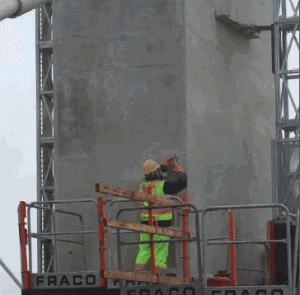Recently I was at my favourite cafe. It’s small and strangers talk to each other a lot, which is one of the things I love about it (aside from the delicious coffee).
A construction worker came in, all caked in dust after a hard day’s work. He said he had been working beside a young guy using a jackhammer all day. That’s why his skin, hair, and clothing were covered in grey dust.
Considering my interest in workplace safety, I couldn’t help but ask: “What kind of respiratory protection were you using?”
He laughed scornfully and said, “They offered me a mask, but I just said: ‘Look at all this nose hair! I’m old [early 40s?] and I grow a lot of nose hair now, so I might as well use it for something!'”
I was pretty horrified – recalling a WorkSafeBC video I’d once seen, which shows how silica particles released from cement are inhaled deep into the lungs where they embed and fester.
“Whoa!” I exclaimed, not sure what to say. Should I whip out my laptop and show him the video? He was laughing – leaning back, pointing towards the thick shoots of nostril hair coming out of his nose. A couple of other people in the coffee line-up were laughing at his gestures.
“I’d take the mask!” I said, wondering how much of a safety message I could get out in a very short time. “That stuff is no good for you!”
He picked up his coffee, still chuckling, walked outside, and lit a cigarette. I shook my head in disbelief, and thought to myself: “I am so writing a blog post about this!”
Dangers of silica
I wish I’d had more time to tell him this: “Many common construction work tasks generate harmful levels of crystalline silica dust if proper controls are not followed,” says the WorkSafeBC website. “When silica dust builds up in your lungs, you are at risk of developing a serious lung disease called silicosis, which can lead to death. Silicosis is not curable, but it is preventable.”
According to an article in WorkSafe Magazine’s July/Aug 2009 issue, there are a number of steps to controlling silica exposure risk, including but not limited to personal protective equipment: “A full- or half-face air-purifying respirator (depending on the work) will provide the last line of defence to the worker responsible for cutting, drilling, and grinding.”
Here’s the video showing how breathing in silica dust can cause permanent damage to the lungs.
See Developing a Silica Exposure Control Plan at the WorkSafeBC website.



